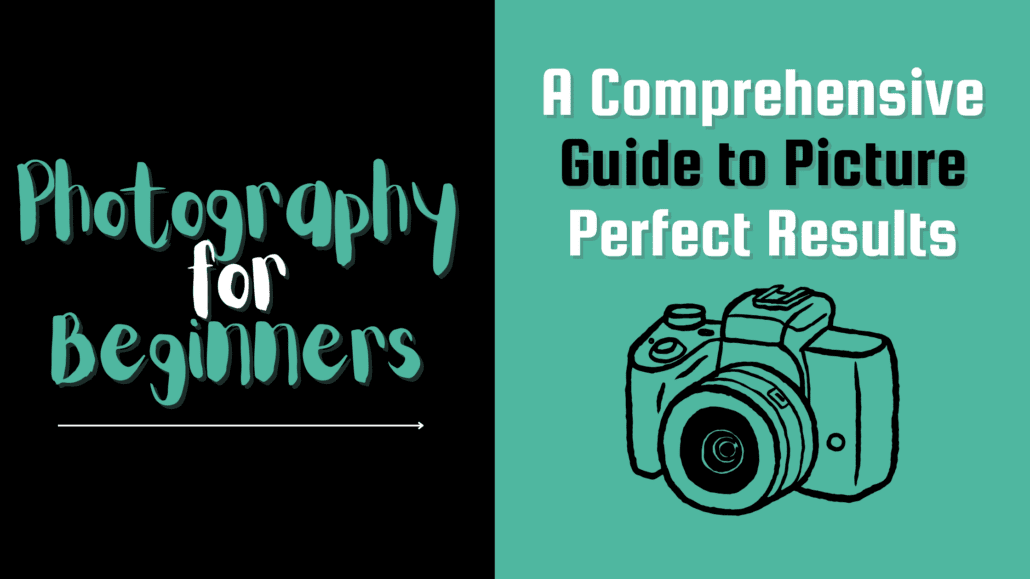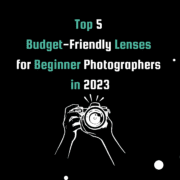Photography for Beginners: A Comprehensive Guide to Picture Perfect Results

Photography for Beginners: Don’t Let The Camera Intimidate You
Photography for beginners – an extraordinary art form that freezes moments, evokes emotions, and tells stories without uttering a word. It invites us to explore, create, and preserve memories, expressing our unique perspectives and sharing our vision with the world.
In today’s digital age, the popularity of photography has skyrocketed. With the ubiquity of smartphones and the rise of social media platforms, captivating images flood our feeds, connecting us and inspiring us through visual storytelling. Photography has become a powerful means of self-expression, connecting with others, and showcasing our individuality.
But its appeal goes far beyond the digital realm. Throughout history, photographers have captured iconic moments that shaped society and changed perspectives. From the early days of film to the modern digital era, photography has left an indelible mark.
Why Should You Learn Basic Photography Skills?
Learning basic photography skills opens up a world of creative possibilities. It allows us to preserve cherished memories, see the world through a new lens, and capture fleeting moments that hold a lifetime of meaning.
In this comprehensive article, I’ll cover the basics of photography for beginners, from understanding different types of cameras to mastering composition, lighting, and editing techniques. We’ll explore the art of storytelling through motion, the magic of focus and depth of field, and the pivotal role of light in photography. Along the way, we’ll provide practical tips, personal anecdotes, and resources to guide you on your photographic journey.
So, whether you’re a beginner just starting out or someone passionate about photography looking to enhance your skills, join us as we unlock the secrets of photography for beginners together. Let’s embark on an exciting adventure, capturing the world’s beauty one click at a time.
Photography for Beginners: Getting Started
To begin your journey into the world of photography for beginners, it’s essential to understand the basics. In this section, we’ll cover the different types of cameras, essential camera features and settings, and how to select the right camera for beginners.
A. Understanding the Different Types of Cameras
Cameras come in various types, each offering unique features and capabilities:
- Digital Single Lens Reflex (DSLR) Cameras: Popular among enthusiasts and professionals, DSLRs offer versatility, interchangeable lenses, and advanced manual controls.
- Mirrorless Cameras: Gaining popularity for their compact size and performance, mirrorless cameras offer interchangeable lenses and advanced features.
- Point-and-Shoot Cameras: Compact and easy to use, point-and-shoot cameras are ideal for beginners with automatic settings and built-in lenses.
- Smartphone Cameras: Equipped with powerful cameras, smartphones provide convenience and portability for casual photography.
B. Essential Camera Features and Settings
Understanding essential camera features and settings empowers you to take control of your photography:
- Resolution and Megapixels: Higher megapixel counts result in sharper and more detailed images.
- ISO: Adjusts the camera’s sensitivity to light, with higher settings suitable for low-light conditions.
- Shutter Speed: Controls the duration the camera’s shutter remains open, influencing the amount of light and capturing motion.
- Aperture: Controls the size of the lens opening, affecting the depth of field and background blur.
- White Balance: Adjusts color temperature for accurate and natural-looking colors under different lighting conditions.
C. Selecting the Right Camera for Beginners
Consider these factors when selecting your first camera:
- Budget: Determine your budget range to narrow down options.
- Intended Use: Identify specific needs for casual photography, travel, or potential career paths.
- Ergonomics and User-Friendliness: Test cameras for comfort, layout, and ease of operation.
- Reviews and Recommendations: Seek insights from reputable sources and experienced photographers.
Remember, as a beginner, it’s not necessary to invest in the most expensive or advanced camera right away. Focus on understanding the fundamentals and mastering basic techniques. Upgrading can come later as you progress.
In this digital age, photography has become more accessible than ever before. With smartphones equipped with impressive cameras, you can start your journey with the device in your pocket. If you prefer a dedicated camera, consider entry-level DSLR or mirrorless options for more control and versatility.
Ultimately, the right camera for beginners fits your budget, aligns with your intended use, and feels comfortable to handle. The camera is a tool, and your passion, creativity, and understanding of photography are what truly matter in creating compelling images.
Now that you have a better understanding of different camera types, essential features, and selecting the right camera, you’re ready to unleash your creativity and capture the world through your lens!
Photography for Beginners: Mastering Composition
Composition plays a vital role in creating visually appealing and impactful photographs. It’s the art of arranging elements within the frame to convey a specific message or evoke emotions. In this section, we’ll explore some fundamental composition techniques to enhance your photography skills.
A. Rule of Thirds and Its Application
The Rule of Thirds is a widely used guideline in photography composition. Imagine dividing your frame into a grid of nine equal parts by drawing two horizontal and two vertical lines. The points where these lines intersect are called the “points of interest.” By placing your subject or key elements along these points or along the lines, you can create a visually balanced and dynamic composition. For example, placing the horizon on the lower third of the frame when capturing a landscape can create a sense of depth and balance.
B. Framing Techniques for Better Photos
Framing is a powerful technique that adds depth and context to your photographs. By using elements within the scene to create a natural frame around your subject, you draw attention to the main focal point and guide the viewer’s gaze. This can be achieved by using archways, windows, branches, or any other element that surrounds your subject. Experiment with different framing techniques to create unique and captivating compositions.
C. Using Leading Lines and Diagonals
Leading lines and diagonals are effective composition techniques that draw the viewer’s eye into the image and create a sense of movement or depth. These lines can be straight, curved, or even implied. They can guide the viewer’s gaze towards the main subject or create a visual journey within the frame, adding interest and impact to your photos. For instance, a winding road or a row of trees can act as leading lines that lead the viewer’s eye towards the main subject.
D. Exploring Symmetry and Patterns
Symmetry and patterns can create visually striking compositions. Symmetrical compositions have a sense of balance and harmony, where the elements on one side mirror those on the other. Patterns, on the other hand, involve the repetition of shapes, colors, or textures. By incorporating symmetry or patterns into your photos, you can create images that are visually captivating and mesmerizing. Look for architectural structures, natural formations, or intricate designs that exhibit symmetry or patterns.
Remember, these composition techniques are not rigid rules but rather guidelines to help you create visually pleasing images. Experiment with different angles, perspectives, and compositions to find what works best for your subject and desired outcome. As you practice and develop your artistic eye, you’ll discover your own unique style and approach to composition.
In the next section, we’ll explore the importance of lighting in photography and how it can dramatically impact the mood and visual impact of your images. Get ready to shed light on the world of photography and take your skills to the next level!
Photography for Beginners: Understanding Light
Light is the essence of photography for beginners and experts alike. It shapes the mood, enhances details, and brings life to your images. In this section, we’ll explore the significance of light in photography, the difference between natural and artificial light, the magic of the golden hour, and how to control exposure using the histogram.
A. The Role of Light in Photography
Light is the key ingredient that transforms an ordinary scene into a captivating photograph. It affects the colors, shadows, highlights, and overall atmosphere of the image. Understanding how light interacts with your subject and the environment is crucial for creating visually appealing and impactful photographs. Here are some practical tips for working with different types of light:
- Soft and diffused light on overcast days can create a gentle, even illumination, perfect for capturing portraits or close-up details.
- Harsh midday sunlight can produce strong shadows and high contrast. Consider using techniques like fill flash or diffusers to soften the light and reduce the contrast.
B. Natural Light vs. Artificial Light
Natural light, as the name suggests, is the light that comes from natural sources such as the sun, moon, or fire. It offers a variety of qualities depending on the time of day, weather conditions, and geographical location. Natural light can range from soft and diffused during cloudy days to warm and golden during sunrise or sunset. Here are some tips for working with natural light:
- During sunrise and sunset, the light is warm and golden, creating a beautiful and flattering glow. Experiment with different angles and compositions to make the most of this magical light.
Artificial light, on the other hand, is generated by artificial sources like lamps, flashlights, or studio lighting. It provides more control over the intensity, direction, and color temperature, allowing photographers to shape and manipulate the light to suit their creative vision. Here are some tips for working with artificial light:
- When using artificial lighting, consider the color temperature of the light source and how it interacts with the ambient light. Balancing the color temperatures can help create a cohesive and natural-looking image.
C. Golden Hour and Its Significance
The golden hour refers to the period shortly after sunrise or before sunset when the sunlight has a warm, soft, and golden quality. It is a magical time for photography, as the low angle of the sun creates long shadows, beautiful colors, and a flattering glow. The golden hour offers a stunning quality of light that adds depth, warmth, and a touch of enchantment to your images. Here are some tips for capturing the golden hour:
- Plan your shoot in advance, as the golden hour is relatively short. Arrive early and scout your location to make the most of this magical time.
D. Controlling Exposure and Using the Histogram
Exposure refers to the amount of light that reaches the camera’s image sensor. Achieving the correct exposure is crucial to ensure that your photos are properly lit and have the desired tonal range.
The histogram is a graphical representation of the tonal distribution in your image. It displays the distribution of light and dark tones, helping you evaluate the exposure. By analyzing the histogram, you can determine whether your image is overexposed (too bright) or underexposed (too dark) and make adjustments accordingly. Here are some practical tips for controlling exposure and using the histogram effectively:
Histogram 101
- Expose for the highlights: When capturing a scene with a wide dynamic range, such as a bright sky and dark foreground, expose for the highlights to avoid overexposing the bright areas. This ensures that important details are retained in the brightest parts of the image.
- Bracketing: To ensure you capture the best exposure, consider using exposure bracketing. This technique involves capturing multiple exposures of the same scene, each with a different exposure setting. It allows you to select the best exposure or merge multiple exposures in post-processing for a well-balanced image.
- Histogram analysis: When reviewing your images, pay attention to the histogram. Ideally, you want a well-distributed histogram with minimal clipping on the extremes. Adjust your exposure settings if you notice any significant spikes or gaps in the histogram to achieve a more balanced exposure.
Learning to control exposure effectively enables you to achieve the desired brightness, contrast, and mood in your photographs. Experimenting with different exposure settings and understanding how to read and interpret the histogram will enhance your technical skills and artistic vision.
As you continue to explore the world of photography for beginners, keep in mind that light is both your subject and your paintbrush. Understanding its characteristics, harnessing its power, and mastering its control will elevate your images to new heights.
In the following section, we will delve into the fascinating world of focus and depth of field in photography. Get ready to explore the art of achieving precise focus and understanding how depth of field can enhance your images. It’s time to sharpen your skills and unlock new dimensions in your photography for beginners journey!
Photography for Beginners: Focus and Depth of Field
Understanding focus and depth of field is essential for creating visually captivating images. In this section, we’ll explore the concepts of autofocus and manual focus, delve into depth of field, discuss how aperture controls depth of field, and provide tips for achieving sharp focus in your photos.
A. Autofocus vs. Manual Focus
Modern cameras offer autofocus (AF) and manual focus (MF) options. Autofocus uses built-in sensors to automatically determine the focus point, making it convenient for quick and accurate focusing. On the other hand, manual focus allows you to take control and adjust the focus manually based on your creative intent. Here are some practical scenarios where each focusing method can be useful:
- Autofocus: Autofocus is often the preferred choice for everyday photography, especially when capturing fast-moving subjects or situations where speed and accuracy are crucial, such as sports or wildlife photography.
- Manual focus: Manual focus provides greater control over focus and can be beneficial in situations where autofocus struggles, such as low-light conditions or when photographing subjects with low contrast. It is also useful for achieving precise focus in macro photography or when creating intentional artistic effects.
B. Depth of Field Explained
Depth of field refers to the range of distance in an image that appears acceptably sharp. It is influenced by factors such as aperture, focal length, subject distance, and sensor size. Understanding depth of field enables you to control which parts of your image are in focus and which parts are intentionally blurred. Here are some practical examples:
- Shallow depth of field: Using a wide aperture (smaller f-stop number) can create a shallow depth of field, where the subject is in sharp focus while the background appears blurred. This technique is commonly used in portrait photography to isolate the subject from distractions.
- Deep depth of field: Using a narrow aperture (larger f-stop number) can increase the depth of field, resulting in more elements throughout the image being in focus. This is beneficial in landscape photography, where you want to capture sharp details from the foreground to the background.
C. Using Aperture to Control Depth of Field
Aperture, represented by the f-stop number, plays a crucial role in controlling depth of field. A wider aperture (smaller f-stop number) creates a shallow depth of field, while a narrower aperture (larger f-stop number) increases the depth of field. Here are some practical tips for utilizing aperture to control depth of field:
- Portraits: For a pleasing background blur and subject separation, use a wider aperture (e.g., f/2.8 or lower) to create a shallow depth of field.
- Landscapes: To ensure sharpness throughout the image, use a narrower aperture (e.g., f/8 to f/16) to increase the depth of field.
D. Achieving Sharp Focus in Your Photos
To ensure your photos are sharply focused, consider the following tips:
- Focus point selection: When using autofocus, choose the appropriate focus point to ensure your desired subject is in focus. Many cameras offer various focus modes, such as single-point autofocus or zone autofocus, allowing you to specify the focus area.
- Focus and recompose: If your subject is not at the center of the frame, use focus and recompose technique. Focus on the subject, then hold the focus by half-pressing the shutter button or using back-button focus, and recompose the shot while maintaining the focus distance.
- Manual focus techniques: In situations where autofocus may struggle, or when you desire more precise control, switch to manual focus. Zoom in on the subject in the camera’s viewfinder or display and adjust the focus manually for precise results.
- Utilize focus aids: Some cameras offer features like focus peaking or focus magnification to assist with manual focusing. Focus peaking highlights the areas of the image that are in focus, while focus magnification allows you to zoom in on the subject for precise focus adjustments.
- Use a tripod: In situations where a slower shutter speed is necessary or when working with macro photography, using a tripod can help minimize camera shake and achieve optimal focus.
By understanding the differences between autofocus and manual focus, mastering depth of field, utilizing aperture settings, and implementing techniques for achieving sharp focus, you’ll have greater control over the visual impact of your images.
In the next section of Photography for Beginners, we will cover the world of camera modes, exploring their functionalities and how they can enhance your photography. Prepare to expand your understanding of camera modes and harness their power to take your creative potential to the next level!
Photography for Beginners: Exploring Camera Modes
Understanding different camera modes is crucial for harnessing the full potential of your camera and capturing stunning images. In this section, we’ll explore the various camera modes, including automatic mode and manual mode, as well as the benefits of shutter priority mode, aperture priority mode, and program mode.
A. Automatic Mode vs. Manual Mode
Cameras often feature automatic mode (Auto) and manual mode (M), offering distinct advantages and control options. Automatic mode takes care of most settings for you, making it ideal for beginners or when you want to quickly capture a moment without worrying about technical adjustments. On the other hand, manual mode provides complete control over settings such as aperture, shutter speed, and ISO, allowing for precise customization to achieve your desired results.
B. Shutter Priority Mode and Its Benefits
Shutter priority mode (Tv or S) is a semi-automatic mode that allows you to set the desired shutter speed while the camera adjusts the other settings accordingly. This mode is particularly useful when capturing moving subjects or controlling motion blur. By selecting a faster shutter speed, you can freeze action, while a slower shutter speed can create a sense of motion or intentional blur.
C. Aperture Priority Mode for Creative Control
Aperture priority mode (Av or A) is another semi-automatic mode that enables you to choose the desired aperture while the camera adjusts the remaining settings. This mode is valuable when you want to control depth of field and creative effects. By selecting a wider aperture (smaller f-stop number), you can achieve a shallow depth of field, isolating the subject from the background. Conversely, a narrower aperture (larger f-stop number) increases the depth of field, keeping more elements in focus.
D. Understanding Program Mode
Program mode (P) is a flexible automatic mode that provides a balance between convenience and control. In this mode, the camera selects the optimal combination of aperture and shutter speed, while you have the flexibility to adjust other settings like ISO, exposure compensation, or white balance. Program mode is beneficial when you want some creative input while relying on the camera’s automatic calculations.
By familiarizing yourself with different camera modes, you can choose the one that best suits your shooting scenario and creative vision. As you gain more experience and confidence, exploring manual modes and semi-automatic modes will enable you to have full control over your photography.
In the next section of Photography for Beginners, we’ll dive into the art of capturing motion, from freezing action to creating intentional motion blur. Get ready to bring your images to life by mastering the techniques of capturing dynamic moments!
Photography for Beginners: Capturing Motion
Photography allows us to freeze a moment in time or convey a sense of motion through our images. In this section, we’ll explore techniques for capturing motion, including freezing action with a fast shutter speed, creating motion blur with a slow shutter speed, and using the panning technique for dynamic shots.
A. Freezing Action with Fast Shutter Speed
To freeze action and capture a subject in sharp detail, use a fast shutter speed. This technique is particularly useful for sports photography, wildlife photography, or any situation where you want to capture a precise moment. Set your camera to shutter priority mode (Tv or S) or manual mode (M) and select a fast shutter speed, such as 1/500th of a second or higher, depending on the speed of the subject. This will ensure that the subject is captured without any noticeable motion blur.
B. Creating Motion Blur with Slow Shutter Speed
On the other hand, using a slow shutter speed allows you to create motion blur in your images, conveying a sense of movement or capturing the passage of time. This technique works well for photographing flowing water, light trails, or any scene where you want to add a dynamic and artistic touch. To achieve motion blur, set your camera to shutter priority mode (Tv or S) or manual mode (M) and select a slow shutter speed, such as 1/30th of a second or slower. Use a tripod or stabilize your camera to ensure that the subject motion is the primary source of blur, rather than camera shake.
C. Panning Technique for Dynamic Shots
The panning technique involves tracking a moving subject horizontally while using a slower shutter speed. This technique helps to keep the subject sharp while blurring the background, creating a sense of speed and dynamism. To use the panning technique, set your camera to shutter priority mode (Tv or S) or manual mode (M) and choose a shutter speed that is slightly slower than the subject’s speed. As the subject moves, follow it smoothly with your camera, keeping it in the same position in the frame. Experiment with different shutter speeds and practice the technique to achieve compelling results.
Mastering the art of capturing motion allows you to tell dynamic and engaging stories through your photographs. Whether freezing action, creating motion blur, or using the panning technique, understanding these techniques and experimenting with different settings will elevate your photography to new heights.
In the next section of Photography for beginners, we’ll explore basic editing techniques to enhance your photos and bring out their full potential.
Photography for Beginners: Basic Editing Techniques
While capturing a great photograph is important, post-processing through photo editing software can take your images to the next level. In this section, we’ll introduce you to photo editing software, cover essential editing techniques such as adjusting exposure, contrast, and white balance, enhancing colors and saturation, and cropping and resizing images.
A. Introduction to Photo Editing Software
Photo editing software provides a wide range of tools and features to enhance and modify your images. Here are some popular photo editing software options:
- Adobe Photoshop: Adobe Photoshop is a powerful and versatile software widely used by photographers and professionals. It offers comprehensive editing tools, advanced features, and endless possibilities for manipulating and enhancing images. You can learn more about Adobe Photoshop here.
- Adobe Lightroom: Adobe Lightroom is a photo editing software specifically designed for photographers. It offers intuitive editing tools, efficient workflow management, and non-destructive editing capabilities. Lightroom is available as part of Adobe Creative Cloud, and you can find more information here.
- GIMP: GIMP (GNU Image Manipulation Program) is a free and open-source photo editing software. It provides a wide range of editing tools and features, making it a popular choice for beginners and those on a budget. You can download GIMP here.
B. Adjusting Exposure, Contrast, and White Balance
Exposure, contrast, and white balance are fundamental aspects of a well-balanced photograph. Photo editing software allows you to fine-tune these parameters to enhance your images:
- Exposure: Adjust the exposure to control the overall brightness or darkness of your image. Increase exposure to brighten underexposed areas or decrease exposure to darken overexposed areas.
- Contrast: Adjust contrast to increase or decrease the difference between light and dark areas in your image. This helps improve the overall tonal range and make your subject stand out.
- White Balance: Correct white balance to ensure accurate color representation in your images. Adjust the white balance to eliminate color casts caused by different lighting conditions.
C. Enhancing Colors and Saturation
Color enhancement can breathe life into your images and make them visually appealing. Use photo editing software to:
- Adjust Colors: Fine-tune individual colors or color channels to achieve the desired look. Enhance or tone down specific colors to create a harmonious balance.
- Increase Saturation: Boost saturation to make colors more vibrant and vivid. However, be careful not to overdo it, as excessive saturation can lead to unnatural-looking images.
D. Cropping and Resizing Images
Cropping and resizing allow you to frame your images and prepare them for specific purposes:
- Cropping: Crop your images to remove unwanted elements, improve composition, or emphasize your subject. Experiment with different cropping ratios to find the most visually pleasing composition.
- Resizing: Resize your images to fit specific dimensions for web sharing, printing, or other purposes. Maintain the aspect ratio to avoid distorting the image.
Remember, photo editing is a creative process, and the aim is to enhance your images while maintaining their authenticity. Experiment with different editing techniques, but always trust your artistic vision.
In the next section, we’ll explore essential accessories that can enhance your photography and make your shooting experience more enjoyable and versatile.
Photography for Beginners: Essential Accessories
As a beginner in photography, having the right accessories can enhance your shooting experience and help you achieve better results. In this section, we’ll explore essential accessories for beginners, including tripods, filters, remote shutter releases, and camera bags/storage options.
A. Tripods and Their Importance
A tripod is a crucial accessory that provides stability and allows you to capture sharp images in various situations. Here’s why tripods are essential:
- Stability: Tripods eliminate camera shake caused by handheld shooting, especially in low-light conditions or when using slower shutter speeds. They ensure your images remain sharp and crisp.
- Long Exposures: Tripods are invaluable for capturing long exposures, such as astrophotography or silky waterfalls. They keep your camera steady during the extended exposure times required for these types of shots.
- Composition and Framing: Tripods provide a stable base that allows you to carefully compose your shots and experiment with different angles and perspectives.
B. Filters for Creative Effects
Filters are versatile accessories that can enhance your creativity and achieve specific visual effects. Here are some commonly used filters:
- UV Filters: UV filters primarily serve as protection for your camera lens, reducing the risk of scratches, dust, and fingerprints. They also minimize the impact of ultraviolet light, resulting in clearer and more vibrant images.
- Circular Polarizing Filters: Circular polarizing filters reduce reflections and glare, enhance color saturation, and improve contrast. They are particularly useful for landscape photography and shooting through glass or water surfaces.
- Neutral Density Filters: Neutral density (ND) filters reduce the amount of light entering the lens without affecting the color balance. They allow you to use longer shutter speeds, creating motion blur effects or achieving a shallow depth of field in bright conditions.
C. Remote Shutter Release for Stability
A remote shutter release is a handy accessory that allows you to trigger the camera shutter without physically touching the camera. Benefits of using a remote shutter release include:
- Minimizing Camera Shake: By eliminating the need to touch the camera during exposure, remote shutter releases help prevent camera shake, ensuring sharper images, especially when using longer shutter speeds or capturing self-portraits.
- Convenience: Remote shutter releases give you the flexibility to trigger the shutter from a distance, enabling you to be in the frame for self-portraits or capture wildlife without disturbing the subject.
D. Camera Bags and Storage Options
Investing in a good camera bag and storage options is essential for protecting your gear and ensuring convenient transportation. Consider the following:
- Camera Bag: A camera bag provides dedicated compartments and padding to safely store your camera body, lenses, and accessories. Look for a bag that suits your needs in terms of size, comfort, and accessibility.
- Memory Card Storage: Carry spare memory cards and use protective cases or card wallets to prevent loss or damage. Organize and label your memory cards to easily identify used and unused cards.
- Backup Solutions: It’s crucial to have a reliable backup system for your digital files. Consider external hard drives, cloud storage services, or online backup solutions to ensure your precious photos are safely stored.
By investing in these essential accessories, you’ll enhance your photography capabilities, protect your equipment, and have a more enjoyable shooting experience.
In the next section of Photography for Beginners, we’ll explore how to develop your photographic eye and train yourself to see the world through a creative lens.
Photography for Beginners: Developing Your Photographic Eye
Developing a photographic eye is a transformative journey that significantly enhances the quality and impact of your photographs as a beginner. In this section, we’ll explore strategies to cultivate your artistic vision and capture images that truly resonate with your audience. By understanding the profound impact of developing a photographic eye, studying renowned and contemporary photographers, engaging in practical exercises and tangible challenges, embracing the joy of exploration, and learning from every experience, you’ll unlock your creative potential and embark on an extraordinary journey of growth and self-expression.
Let’s talk about the following techniques:
A. Understanding the Profound Impact
Developing a photographic eye goes beyond capturing visually pleasing images. It empowers you to effectively convey emotions, tell compelling stories, and connect with viewers on a deeper level. Imagine a photograph that makes you feel a sense of awe, nostalgia, or wonder. By honing your artistic vision, you’ll understand how to use composition, lighting, timing, and other elements to evoke specific emotions and create images that elicit powerful responses. Your photographs will communicate narratives, evoke memories, and inspire contemplation. Each click of the shutter becomes an opportunity to capture moments that transcend the ordinary and leave a lasting impression.
B. Studying the Works of Renowned and Contemporary Photographers
Studying the works of renowned photographers is essential in understanding the foundations of photography and learning from the masters. Take the time to explore the contributions of photographers like Ansel Adams, Henri Cartier-Bresson, and Annie Leibovitz. Delve into their images, analyze their compositions, lighting techniques, and storytelling approaches. Gain insights into their unique perspectives and artistic choices. But don’t stop there. To broaden your horizons and fuel your creativity, immerse yourself in the works of contemporary photographers who are pushing boundaries and revolutionizing the art form. Discover the fresh perspectives, innovative techniques, and creative approaches of photographers like Brooke Shaden, Fan Ho, or Cristina Mittermeier. By studying both the legends of the past and the visionaries of the present, you’ll gain a broader understanding of the art form, stay informed about current trends and developments, and find inspiration that resonates with your own artistic vision.
C. Engaging in Practical Exercises and Tangible Challenges
Practical exercises and tangible challenges are instrumental in honing your photographic eye and translating theory into practice. Tailor your exercises to your skill level, areas of interest, and preferred genres. Here are a few prompts to inspire your creative exploration:
- The Power of Light: Capture the transformative effect of different lighting conditions on your subjects, be it soft morning light, dramatic shadows, or golden hour hues. Experiment with backlighting, silhouettes, or chiaroscuro to evoke specific moods or enhance the visual impact of your images.
- Visual Storytelling: Create a series of images that narrate a compelling story, capturing the essence of a place, a person, or an event through a coherent sequence. Focus on the progression of images, exploring the use of composition, timing, and visual elements to convey a clear narrative arc.
- Exploring Perspectives: Experiment with unconventional angles, unique vantage points, or perspectives that challenge the viewer’s perception of the subject. Get low to the ground, climb to higher viewpoints, or try unusual camera angles to capture perspectives that offer fresh insights and engage viewers in new ways.
- The Language of Color: Focus on the emotional impact of color in your photographs. Explore how color combinations, contrasts, or monochromatic schemes can evoke specific moods or enhance the visual impact of your images. Pay attention to the color temperature, color harmonies, or color symbolism in your compositions.
These exercises will not only sharpen your technical skills but also encourage you to think critically, experiment and develop your own signature style. Remember to approach these exercises with an open mind, allowing yourself to explore different possibilities and take risks. Embrace the process of trial and error, as it is through experimentation that you’ll discover new techniques, refine your artistic sensibilities, and develop a unique visual language.
D. Embrace the Joy of Exploration and Learn from Every Experience
Embrace the joy of exploration and see each photographic experience as an opportunity for growth and self-discovery. Don’t shy away from failure or setbacks; instead, use them as stepping stones toward improvement. When faced with unsuccessful shots, take the time to analyze them objectively, identify areas for improvement, and learn from your mistakes. Embrace the growth mindset and approach each experience with curiosity, resilience, and a desire to continuously learn and improve. Remember, it’s through the process of exploration, experimentation, and learning from every experience that you’ll refine your photographic eye and develop a unique artistic voice.
Conclusion
In conclusion, developing a photographic eye is an extraordinary journey that spans a lifetime of learning and creative expression. By understanding the profound impact of developing this eye, studying the works of renowned and contemporary photographers, engaging in practical exercises and tangible challenges, embracing the joy of exploration, and learning from every experience, you’ll embark on an extraordinary path of growth and self-expression in photography.
As you embark on this remarkable journey, remember that developing a photographic eye is not just about capturing beautiful images—it’s about communicating stories, emotions, and perspectives through your photographs. It’s about expressing your unique vision and making a meaningful connection with your audience. Every photograph you take is an opportunity for self-expression and growth.
So, embrace the challenges, push your boundaries, and continuously seek new inspiration. With each click of the shutter, you’ll refine your artistic vision, expand your creative horizons, and uncover new depths within yourself as a photographer.
Now that you have a solid foundation in developing your photographic eye, the next section will provide you with a curated list of resources and further learning opportunities. From workshops and online courses to recommended books and exhibitions, these resources will support your ongoing growth and fuel your passion for photography.
Photography for Beginners: Resources and Further Learning
As you continue to develop your photographic eye, accessing valuable resources and learning opportunities becomes crucial. In this section, we’ll explore various avenues for further learning, inspiration, and continuous improvement, providing specific descriptions and suggestions to help you make informed decisions about which resources to explore.
A. Books and Online Tutorials
Explore these recommended resources to deepen your knowledge and hone your skills:
- “Understanding Exposure” by Bryan Peterson
- “The Photographer’s Eye” by Michael Freeman
- “National Geographic Ultimate Field Guide to Photography“
B. Photography Courses and Workshops
Expand your learning with courses from various platforms, including:
C. Joining Photography Communities and Forums
Connect with fellow photographers and seek mentorship through:
- DPReview
- PhotographyTalk
- Instagram: Engage with the photography community using relevant hashtags and by following photographers whose work inspires you.
- Flickr: Join groups and participate in discussions to connect with photographers and share your own work.
D. Tips for Continuous Improvement
Apply these practical tips to foster continuous growth:
- Regular Practice: Keep your camera with you and actively seek opportunities to photograph. Challenge yourself to explore different subjects and experiment with new techniques.
- Critical Analysis of Your Work: Regularly review your photographs and assess what worked well and what can be improved. Embrace constructive criticism and use it as a tool for growth.
- Experimental Exploration: Step out of your comfort zone and try new techniques, genres, or creative approaches. Embrace the unexpected and allow yourself to make mistakes as you push the boundaries of your creativity.
- Attendance of Exhibitions and Exploration of Photography Galleries: Visit exhibitions and galleries to immerse yourself in the work of established photographers. Observe their compositions, lighting techniques, and storytelling methods to expand your visual understanding and gain inspiration.
By utilizing these resources and engaging in continuous learning, you’ll cultivate a strong photographic eye and continue to grow as a photographer. Embrace the journey, seek inspiration, and let your unique vision shine through your images.
Wrapping Up (Woo! That was a long one!)
Congratulations on reaching the end of this comprehensive guide on photography for beginners! Throughout this journey, we have covered a wide range of topics and techniques to help you develop your skills, enhance your creativity, and embark on a fulfilling photography journey.
In conclusion, photography is a dynamic and ever-evolving art form that allows you to express your unique perspective and connect with the world around you. As a beginner, you have now gained a solid foundation in photography fundamentals and techniques. Embrace the journey ahead with enthusiasm, curiosity, and a willingness to continuously learn and grow.
Remember, photography is a deeply personal and creative pursuit. Trust your instincts, develop your own style, and let your passion guide you. Capture the beauty and moments that inspire you, and share your unique vision with the world.
Now, armed with the knowledge, skills, and resources shared in this guide, it’s time to unleash your creativity and embark on a remarkable photography adventure. Remember, the best photographs are yet to be taken, and your unique perspective will make a lasting impact. Embrace the joy of photography, embrace the journey, and let your photographic vision shine!
Tony has a bachelor’s degree from the University of Phoenix and over 11 years of writing experience between multiple publications in the tech, photography, lifestyle, and deal industries.











Leave a Reply
Want to join the discussion?Feel free to contribute!